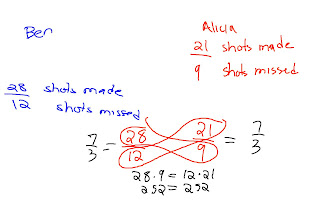Saturday, January 26, 2008
Friday, January 25, 2008
1/25/08
1/25/08 U3 scribe post
We checked the classwork and homework and went over them. We learned about Similar Figures which is the relationship (ratio) between the corresponding sides of two figures are equivalent. For Example compare two rectangles
1st rectangle: length of 2, width of 4
2nd rectangle: length of 4, width of 8
then we had to complete classwork
he showed us an example of #6 on the class work
He showed us that when you want to check if you have the right answer you should divide the numbers in the fraction to get decimals and if the decimals are the same then that’s the right answer.
Next scribe: Ashely Melendez
We checked the classwork and homework and went over them. We learned about Similar Figures which is the relationship (ratio) between the corresponding sides of two figures are equivalent. For Example compare two rectangles
1st rectangle: length of 2, width of 4
2nd rectangle: length of 4, width of 8
then we had to complete classwork
he showed us an example of #6 on the class work
He showed us that when you want to check if you have the right answer you should divide the numbers in the fraction to get decimals and if the decimals are the same then that’s the right answer.
Next scribe: Ashely Melendez
Thursday, January 24, 2008
1/24/08
1/24/08
Today, We talked about Determining Equivalent Fractions on the smart board. Mr. Rochester asked the class how to determine if fractions are equivalent. Graham answered by saying that you can find a common denominator to determine whether the fractions are common. We also determined that cross multiplication is another way: 1/2=2/4 - cross multiplying the 1 and 8, and 2 and 4 will give you the product of eight, which means they are equivalent. We also figured that by just dividing the fractions we would know if they are equivalent: 1/2, 4/8, they both equal .5 or 1/2.
The Scribe for the next class: Ozzy Dembowski
Today, We talked about Determining Equivalent Fractions on the smart board. Mr. Rochester asked the class how to determine if fractions are equivalent. Graham answered by saying that you can find a common denominator to determine whether the fractions are common. We also determined that cross multiplication is another way: 1/2=2/4 - cross multiplying the 1 and 8, and 2 and 4 will give you the product of eight, which means they are equivalent. We also figured that by just dividing the fractions we would know if they are equivalent: 1/2, 4/8, they both equal .5 or 1/2.
The Scribe for the next class: Ozzy Dembowski
Wednesday, January 23, 2008
Subscribe to:
Comments (Atom)




